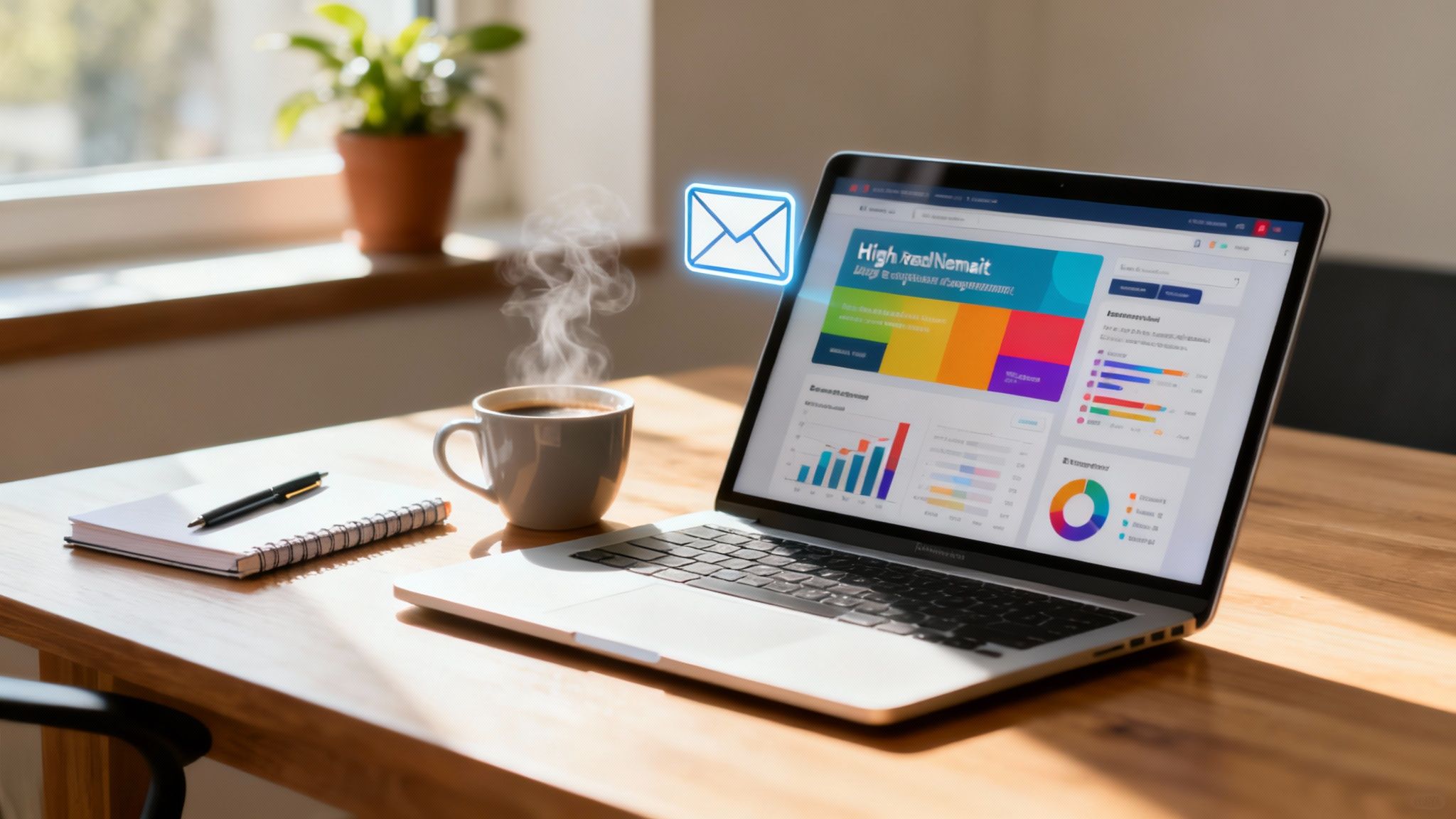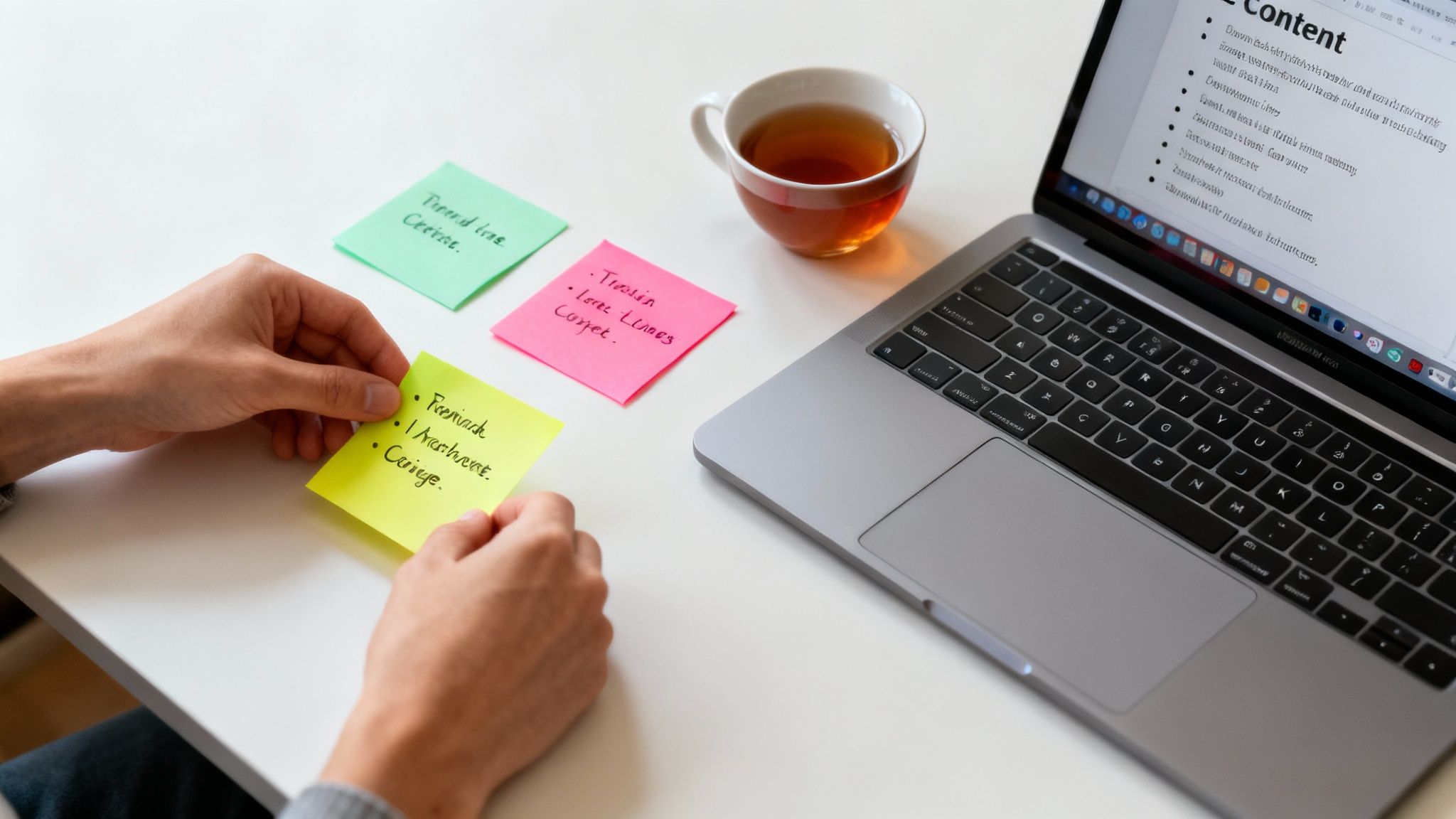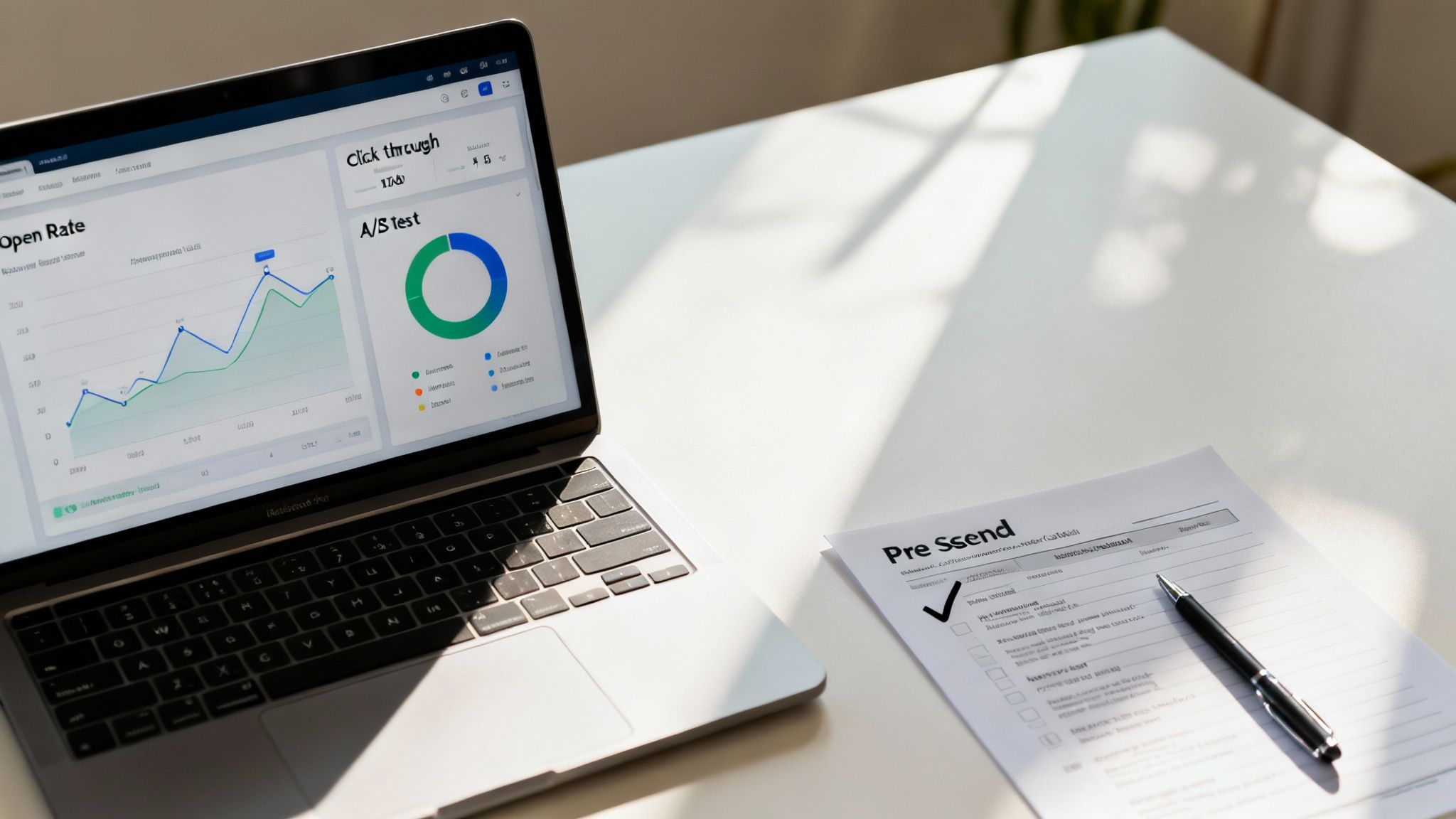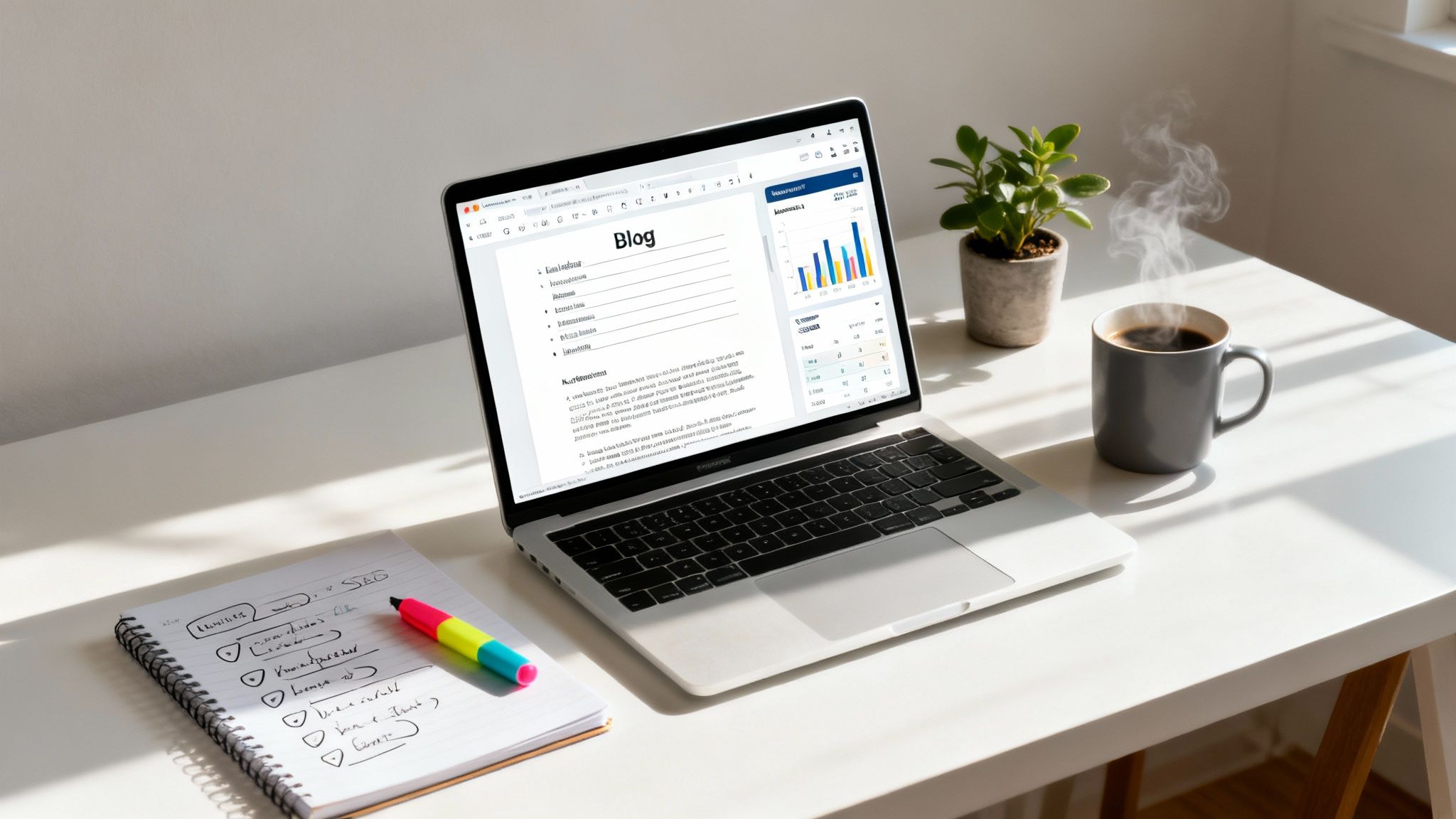
Staring at a blank screen, trying to figure out how to make a newsletter email that people actually want to read? You're not alone. Many creators and marketers struggle to cut through the noise of a crowded inbox, sending emails that get ignored or deleted. The real challenge isn't just hitting "send"—it's forging a genuine connection that turns subscribers into loyal fans. This guide offers a practical roadmap to skip the generic advice and build a newsletter that delivers real value, builds community, and achieves your goals.
Your Foundation for a Must-Read Newsletter

A solid newsletter strategy is a cornerstone of any good content plan. It's a powerful tool that can do everything from boosting audience engagement to generating new leads. A great newsletter weaves seamlessly into your other communication efforts, creating a consistent brand experience. By defining your mission, truly understanding your readers, and crafting valuable content, you’ll have a clear strategy for a newsletter that doesn’t just get opened, but helps build a loyal community around your brand. To see how it all fits together with other smart tactics, it's worth exploring these marketing automation best practices.
Pinpoint Your Newsletter's Purpose and Audience
Before you even think about a template or a clever subject line, get crystal clear on two things: your "why" and your "who." Jumping straight into writing without this foundation is a surefire recipe for a newsletter that’s a chore to write and a bore to read. A newsletter without a focused mission just ends up being a random collection of content, and nobody has time for that. Let's start at the beginning.
Define Your Primary Goal
First, what’s the point? Your newsletter needs a specific job to do that supports a larger business goal. Every element, from the header to the postscript, should work toward that one objective. A single newsletter can't be everything to everyone, so pick a primary focus.
Common goals include:
- Driving Sales: Announce new products, share exclusive discounts, or highlight glowing customer testimonials to impact the bottom line.
- Building a Community: Share behind-the-scenes content, user-generated stories, or spark conversations to foster long-term loyalty.
- Establishing Thought Leadership: Position yourself as the expert by sharing deep-dive analysis, industry insights, and unique perspectives.
- Increasing Website Traffic: Curate your best blog posts, guides, or resources to pull subscribers back to your site for more.
A well-defined goal is your ultimate filter. As you're deciding what to include, ask yourself, "Does this directly support my primary goal?" If not, save it for another channel.
Understand Who You're Writing For
Now that you have your 'why,' it's time to nail down your 'who.' Generic content gets ignored. To make an impact, you need to understand your subscribers' real-world problems, interests, and motivations. Instead of guessing, create a simple audience persona—a semi-fictional snapshot of your ideal subscriber.
Ask yourself a few questions to bring this person to life:
- What's their biggest professional challenge right now? A marketer might be struggling to generate leads, while a freelancer is stressing about finding their next client.
- What are they genuinely curious about in your industry? Maybe they want to know about emerging trends, new tools, or case studies.
- What kind of content do they already love? Are they into short, actionable tips? Or do they prefer in-depth tutorials?
This clarity is what makes every email feel personal and valuable. To take it a step further, look into creating personalized newsletters tailored to individual interests. This foundational work turns passive readers into engaged fans.
Design a Visually Engaging Newsletter Structure

Even the most brilliant content can fall flat if it’s trapped in a clunky, hard-to-read design. Creating a visually engaging structure isn't about adding flashy graphics; it’s about clarity, professionalism, and guiding your reader’s eye effortlessly. Your newsletter's design is the first impression you make after the open. A clean, well-organized template builds trust and makes your content feel more valuable before your subscriber has even read a single word. This structure needs to be consistent, reinforcing your brand identity with every send.
Craft a Winning Template
Every effective newsletter is built on a similar foundation. These core components are the skeleton of your email, creating a smooth reading experience every time. A solid, reusable template means you’re not reinventing the wheel for every issue. Your template should have a few non-negotiable parts. Let's break down the anatomy of an effective email design.
Key Components of a Newsletter Template
Here’s a look at the essential structural elements every newsletter should include to ensure your emails are clear, effective, and user-friendly.
| Component | Purpose | Best Practice Example |
|---|---|---|
| Header | Instantly identifies you as the sender and establishes brand recognition. | A clean section at the top featuring your company logo and a link to your website. |
| Main Body | Houses your primary content, from featured articles to product updates. | Breaks up text with headings, short paragraphs, and relevant images or GIFs to keep it scannable. |
| Call-to-Action (CTA) | Guides readers to take a specific action, like reading a blog post or making a purchase. | A brightly colored, clickable button with clear, action-oriented text like "Read More" or "Shop Now." |
| Footer | Provides essential contact info, social links, and legal requirements. | Includes social media icons, a physical address, and a one-click unsubscribe link. |
Adopt a Mobile-First Philosophy
Designing for mobile isn't optional anymore; it’s the standard. With so many people opening emails on their phones, a clunky mobile experience is a surefire way to lose subscribers. A responsive design that adapts to any screen size is non-negotiable. Responsive email designs can boost unique mobile clicks by 15%. Considering that average open rates are hovering around 35.63%, you can't afford to alienate a huge chunk of your audience with a design that’s broken on a small screen. Before you hit send, always send a test email to yourself and open it on your phone.
Use Visual Hierarchy and Branding
Visual hierarchy means using design to draw attention to the most important parts of your newsletter. Your main headline should be the biggest text, followed by smaller subheadings and body copy. This simple structure guides the reader’s eye. Stick to your brand’s colors and fonts to build recognition. A few well-placed accent colors for links and CTAs can make a huge impact. For those looking to get more creative, you can even explore techniques like AI style transfer to give your images a unique look. And don't forget white space—leaving empty areas around text and images reduces clutter and improves readability.
Craft Content Your Subscribers Genuinely Value

With your design locked in, it’s time for the words. This is the heart and soul of your newsletter, where you build a relationship with your readers. You're not just sending an update; you're delivering value and giving them a reason to look forward to your emails. It all starts with getting them to open it. The inbox is a battlefield, with 376 billion emails projected to be sent daily by 2025. A weak subject line is a surrender. The good news? 60% of people still prefer getting brand communications via email.
The Art of the Subject Line
Your subject line and preview text are your one-two punch to make a good first impression. They must be intriguing but also honest—never use clickbait. A great subject line sparks curiosity and provides clarity, hinting at the value inside without giving it all away.
Here are a few proven approaches:
- Ask a Question: "Struggling with content ideas for June?"
- Use Numbers: "3 common mistakes that are hurting your open rates"
- Create Urgency: "Your exclusive discount expires tonight"
- Spark Curiosity: "This AI tool just changed my entire workflow"
Keep it short and punchy. Most phones truncate subject lines after 40-50 characters, so put your most important words first.
Finding Your Content Mix
The best newsletters feel like a mini-magazine, rarely sticking to just one type of content. A balanced mix keeps your audience hooked while pushing toward your main goal. This approach also makes your life easier by creating recurring "segments" or content buckets, which is less intimidating than a blank page.
Try weaving a few of these formats into your newsletter:
- Personal Stories: Give a peek behind the curtain. Share a lesson learned, a project you’re working on, or a challenge you overcame.
- Curated Resources: Link to great articles, tools, or videos from others to position yourself as a trusted filter.
- Exclusive Insights: Give subscribers something they can't get on your blog or social media to make them feel part of an exclusive club.
- Quick Tips & How-Tos: Offer one simple, actionable piece of advice they can use right away for instant value.
To really nail this, learn how to create engaging content that connects with your audience on a human level.
Writing Copy That Converts
Now it's time to write. The golden rules? Keep it clear, concise, and conversational. Use short paragraphs, simple language, and write like you're talking to a friend. Your writing should always guide the reader somewhere, which is where your Call-to-Action (CTA) comes in. Every newsletter needs a clear CTA, whether it's "Read the Full Post" or "Grab Your Template." Make your CTAs pop with a button and text that describes the outcome (e.g., "Show Me the Guide" instead of "Click Here"). Remember, your reader’s time is precious—get to the point and deliver on your promise.
Launch, Analyze, and Refine Your Newsletter

Hitting ‘send’ is just the beginning. The final stage is about sending it smart, learning from the results, and making your next newsletter even better. This is how you evolve a good idea into a data-informed powerhouse, turning your newsletter into a dynamic tool that adapts to what your audience wants. A single broken link or typo can undermine your credibility, so don't skip your final review.
Your Pre-Launch Checklist
Run through this consistent checklist every single time you prepare to launch.
- Proofread Meticulously: Read your copy out loud to catch awkward phrasing, then use a grammar tool for an extra polish.
- Test Every Link: Click on everything, from the logo in your header to the unsubscribe link in the footer, to ensure they go to the right place.
- Preview on Multiple Devices: An email that looks gorgeous on your desktop can be a mess on a phone. Send a test to yourself and check it on both.
The Power of A/B Testing
Guessing what works is a losing game. A/B testing is your best friend for making decisions based on data. It’s simple: you send two slightly different versions of your email to a small slice of your audience and see which one performs better.
Start with elements that have the biggest impact:
- Subject Lines: Test a straightforward, descriptive subject line against one that creates more curiosity.
- Calls-to-Action (CTAs): Compare a blue button versus a green one, or test "Learn More" against "See the Full Guide."
- Sender Name: Does "Chris from MediaWorkbench" perform better than just "MediaWorkbench"?
The golden rule is to test only one variable at a time so you know which change made the difference.
Interpreting Your Key Metrics
Once your campaign is live, the real learning begins. Your email platform's analytics are direct feedback from your audience. Don't get overwhelmed; just focus on the metrics that truly matter.
Get familiar with these core metrics:
- Open Rate: The percentage of subscribers who opened your email, reflecting the effectiveness of your subject line.
- Click-Through Rate (CTR): The percentage who opened and then clicked a link, showing how engaging your content was.
- Unsubscribe Rate: The percentage who opted out. A sudden spike is a red flag that something's wrong.
The growth of newsletters is undeniable. One platform saw emails sent skyrocket from 402 million to 15.6 billion between 2021 and 2024. You can read more about the state of email newsletters on beehiiv's blog. Analyzing your data helps you tap into this momentum effectively, and understanding how to use AI for marketing can help you analyze that data even faster.
Conclusion: Turn Your Newsletter Into a Powerful Asset
And there you have it—a complete playbook for how to make a newsletter email that doesn't just get opened, but builds relationships and achieves results. We've covered the essentials, from defining your core mission and understanding your audience to designing for engagement and analyzing your performance. The key takeaway is this: your newsletter is an ongoing conversation, not a one-off announcement. The newsletters that truly succeed are the ones that show up consistently with a genuine commitment to providing value. Don't be afraid to experiment, listen to feedback, and let your strategy evolve. Nurture it, and your newsletter will grow into one of your most valuable assets.
👉 Ready to stop planning and start creating? Try MediaWorkbench.ai for free and see how simple it can be!
Answering Your Top Newsletter Questions
Here are some no-fluff answers to the most common questions creators and marketers ask, so you can move forward with confidence.
How Often Should I Send My Newsletter?
The best sending schedule is one you can stick to without sacrificing quality. Consistency will always beat frequency.
- Weekly: Perfect for timely content like news, industry updates, or limited-time offers.
- Bi-weekly: A great sweet spot that keeps your brand top-of-mind without overwhelming subscribers.
- Monthly: Works well for deeper, more evergreen content like case studies, comprehensive guides, or thoughtful roundups.
A single, high-value monthly email is far better than four rushed, low-effort weekly ones. Start with what feels sustainable and adjust based on your analytics.
What Are the Most Important Metrics to Track?
Focus on the four metrics that tell the real story of your newsletter's performance.
- Open Rate: A direct reflection of your subject line and sender name's ability to grab attention.
- Click-Through Rate (CTR): Tells you if your content delivered on the promise of your subject line.
- Conversion Rate: Tracks how many subscribers took the action you wanted (e.g., buying a product, signing up), proving your newsletter’s ROI.
- Unsubscribe Rate: A spike here is a red flag that something’s off with your content, frequency, or targeting.
How Do I Grow My Subscriber List?
Growing your list is about attracting the right people. Start with a can't-miss sign-up form on your website (homepage, blog posts, footer). Then, offer a compelling lead magnet—something valuable like a checklist, guide, or discount in exchange for their email. Promote your newsletter everywhere you are online, including social media bios and your email signature. Remember, a small, engaged list of 100 true fans is worth more than a list of 1,000 people who never open your emails.

